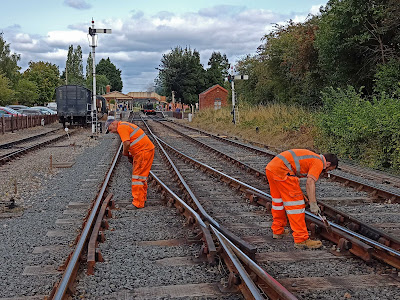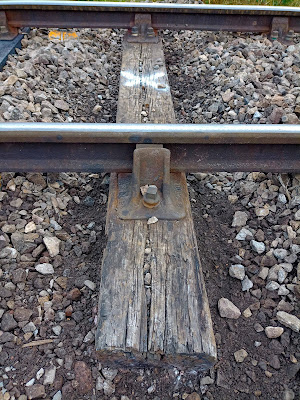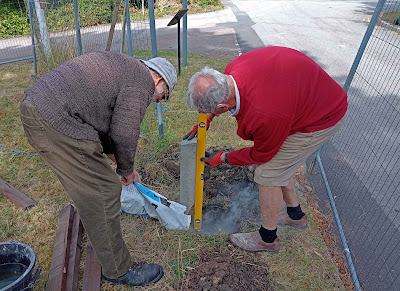Friday at Broadway.
Further brick laying at Broadway on a very sunny Friday, with the added interest of visits from both Growlers, as well as a second train hauled by our Peak loco.
The first to arrive at Broadway was the Peak, the Growler train having gone in the opposite direction.
No fewer than 7 trains were booked to arrive at Broadway during the day.
A bit over an hour later the Growler train arrived at Broadway. This was double headed, something we had never seen before.
The Growler train looked to be quite well filled; the Peak hauled train, less so.
Inside the signal box, time stood still:
 |
| These levers haven't moved for a long time, and operationally, never. |
 |
| Spiders' webs are building up in our new but never used signal box. |
We took a video of the departure. As Blogger only allows short videos to be inserted directly, we cut it short, to show just the bellow and turbo whistle at the start:
John was on the third of the five courses of blues on the plinth, now working along the back. There are 67 bricks between stanchions.
During our work the Peak ran round too. We wondered if every train had new customers, or was it the same people going up and down all day long?
John laid 80 bricks on Friday, which works out to about half way along the back, if you count the section with the 'Gents'.
After laying 80 bricks, a lot of time is taken up with cleaning the work and pointing what was laid during the session.
As this is on a stretch of 1982 laid track, many of the life expired sleepers were second hand when laid, and are now really at the end of their life. About half are still GWR throughbolters, so hammers, wedges and the blog reader sponsored maul were out in use.
This is the sort of defective sleeper we're talking about.
It is split down the middle, the split going right through the location of the chairbolt.
'X' marks the spot.
Being near the middle of the line, we had to wait for two trains to pass before we had any decent time to pull sleepers in and out.
One train goes down to Winchcombe; 15 mins later the other comes back to Toddington. We do sometimes manage to change two sleepers in that short interval (10 mins granted by the signalman) but only if we have prepped the sites beforehand (dug out the ballast)
 |
| One sleeper being 'prepped' by digging it out from the old ballast. |
Lunch time was very pleasant, sitting on the flap of the new Transit, which half a sleeper dragged out from the tracks at your feet.
After lunch and 5 sleepers later we went up to the station itself to check up on a crossing that was reported to be noisy.
We came along this long freight consist, which was about to be shunted northwards by the newly repainted 03.
 |
| Bert Ferrule and Adam check the - er - check rails. |
2807 was waiting in the station, receiving more water and by the looks of the smoke, some extra coal on the fire too.
Not long after we had to step aside, as the big freight engine accelerated its 7 coach train out of the station.
Then it was back to the south end of the yard to tidy up.
The wreckage of the old sleepers was put on the truck, so that we leave a tidy site.
Tuesday at Broadway.
Another day at the (brick) coal face, with just two of us on site.
On arrival at Broadway we were struck by the gaudiness of multiple signs and vinyl posters that have been put up. A new notice declining any responsibility for the public car park has been attached to the fence, as well as 3 single use vinyl posters, about 10 yards' worth, that now go up the drive. What becomes of the vinyl sheets afterwards? This random display does not say 'living museum', the image that our Trust is trying to give.
Up on platform 2 brick laying started again on Tuesday, and the waiting piles of blues have been reduced to just one, not yet opened. There is steady progress then.
Or there was. At 10 o clock both Cleeve Hill and Bredon Hill suddenly disappeared from view, signalling the arrival of heavy rain.
This duly came, accompanied by so much wind that we fled to the other side and bought ourselves coffee, to sit out the mini storm.
The forecast was quite correct though, and after the squalls in the morning the rest of the day was bright, albeit still breezy.
John continued with the third course of blues, closing a gap at the rear. In the picture he is tapping down a specially cut brick, which fits in behind one of the stanchions.
Visiting engines on Tuesday were 2807, and Foremarke Hall. The crew of the 2-8-0 must have much regretted their open cab, as they drove in reverse through the squall over Broadway.
But soon the sun was out again.
Having completed the third course at the back and across the south end, John resumed work on the fourth course at the front.
At the end of the day he had laid 87 blues, taking the fourth course half way along the front.
We look forward to seeing some of the decorative plinth stretchers being laid along here.
The other visitor on Tuesday, 7903 Foremarke Hall, is seen here in front of the stationmaster's house, just about ready to start its run round.
We were up at the top of the cutting to water a number of the replacement pine seedlings. There are two rows as per original, but the top row suffers from lack of water and has developed less quickly because of it. The middle row on the other hand is blossoming, and is now up to 8ft high.
 |
| Picture by Paul Fuller. |
Finally for Tuesday, a little tidbit of information about the Winchcombe Road bridge. This is one for which the railway is not responsible.
A contractor with a cherry picker has been hired in to check the underside, and we understand that the intention is to replace the (concrete) deck later this year. As it's not our bridge we are not financially involved here.
Wednesday with the Usketeers.
Three of us today - no Dave.
While collecting the woodwork we would need, we noticed that Neal (absent during Broadway's brick laying on Tuesday ) had made fantastic progress with the canopy metalwork instead.
What you see here is the start of the last items needed for the canopy, the first of the four trusses laid out, and partially assembled.
With this under way, it was also noticable that the various random lengths of steel piled up under the greenhouse are visibly getting fewer.
Great progress !
Nearby, the contractors that have been laying drains in the Toddington North cutting were loading their machinery on to a large articulated flatbed.
A quick chat revealed that the largest part of the work is complete (hence return of the diggers and dumper) but some minor stuff like pointing the drainage pits still needs to be done.
Off to work then.
The first thing to do is to remove two more panels of the Heras fence, to give us room to assemble the next two sets of rails.
The pile of dismantled Heras panels is growing steadily, replaced by the post & rail fence in the background.
After painting the last 8 pieces of wood for the fence, we brought up 8 rails to make up the next two sets.
John is digging the first of his two holes. This will be the corner post, from where the fence turns left to arrive near the gas marker post.
We had the visit of a Dutch milkmaid today - no, wait, it's John! He was fetching water for the Postcrete, but also to pour down the hole he is digging, to soften the ground.
Another visitor was today's stationmaster, come up to see what we were doing along the Toddington station approach.
It met with approval - phew!
Lunch was held al fresco in the car park. The break also allowed the Postcrete to go off.
With that we were able to measure the distance to the last post that we plan to insert, and John dug the corresponding hole quite quickly - away from the drive there are no stones underground, and his progress was swift.
Here is where we are now, with one more set of rails to go to the top of the drive. Then the fence will swing right, out of the picture.
Once all the posts and rail are in place, we will go back to the beginning and attach the smaller intermediate posts, two per section.
Although the fence is nice and straight here, it is less so around the big tree, as we had to swerve it a bit to avoid roots and an underground cable. We will revisit the line of the fence and make some small adjustments to make it look straighter.
The car park still looked quite busy, and 2807 always makes a fine show at the head of its rake.
Here the Toddington stationmaster today stands proud to receive the train.


































Great progress on the brick work at Broadway.
ReplyDeleteShame to see the signal box looking like it has been closed by B.R., and awaiting domolishion. Hope to see it manned next year, if not before.
Neal has been busy with the steels hasn't he? Well done Neal.
I suppose it is a personal point of view but the S&T building, to me, looks like it was spoilt by the choice of domestic style windows which make it look to me like a large bungalow. Industrial style windows would have looked better. The brick work looks good though.
Regards, Paul.
It's a huge building! What exactly do they intend to do in there?
DeleteSit around drinking tea, allegedly. Hence the "S" and the "T".
DeleteI had the same thought about the windows.
ReplyDeleteIt looks as if the building was designed by committee. It seems a pity given all the attention to detail with the brickwork. Thankfully the Broadway P2 structure looks like being the ‘real’ thing!
DeleteThe vinyl advertising banners, such as those on the Broadway fence, are not
ReplyDeletethe easiest of things to recycle once the event(s) they are advertising have been and gone. Because of the differing chemical compositions of the plastics that make up these banners they cannot be readily separated for re-use, therefore they end up going to either landfill or incineration.
These banners all have dates on which makes the redundant unless you tape new dates over for future years if events continue . My CFDF banners for Food & Drink were not dated so we used them again next time for 4 yearswith date on separate board .QED on saving cost .
ReplyDeleteMore bricklayers coming soon ? John M
As the brickwork went up I was looking forward to seeing what GW features would show in the roof and fittings on the S&T building. Sorry, looks like the money ran out and 1970s Barratt Homes were brought in to finish the job - only a personal opinion but for me it’s a disappointing ‘yuk’.
ReplyDeleteOn the S&T building, it's worth bearing in mind that it's really not in a very publicly viewable spot - it's nestled in a back corner of the yard. Given that, I think a reasonable compromise has been reached, we've got nice brickwork and the overall outline is about right. I agree the windows and lack of acoutrements like chimney stacks and the like don't make it terribly convincing when you stand and look at it, but it is arguably on the fringes of the 'living museum' boundary. I have also heard criticism that they could have had a cheaper pre-fab style building! I was pleased that some effort had been made on the architectural front when the Trust was approving funding to finally provide the long-suffering S&T volunteers with decent facilities. Let's not make perfect be the enemy of good, and pick the heritage battles that matter! P2 building is going to be spot on, and rightly so.
ReplyDeleteWhile I'm here, great work on the fencing, it looks so much better without that Heras fencing.
Oh, and with a gala advertising hat on, I accept the criticism of the banners. However, we do need to promote these events to ensure their success, so alternative suggestions are genuinely gratefully received.
It’s good to see the P2 building developing. With only one bricklayer progress cant be too rapid, but the main thing is that it’s happening! Excellent work by Neal on the canopy steelwork.
ReplyDeleteRichard T
I was interested in the fact that the Winchcombe road bridge is not the responsibility of the GWSR to maintain. A good thing in some respects. Looking forward to seeing John M with a trowel at Broadway! I guessed there would be some observations regarding the new, as yet not quite finished, S&T building. Given that for the past 40 years or so, the S&T Dept has had to work on rather large signalling equipment in the open or in a Mk 1 coach, I'm sure it will be a real asset for them. I recall a story about an estate agent back in the early 1980s telling prospective buyers of the then brand new houses nearby that the GWSR would run out of money before it reached Winchcombe Station. How things turned out!
ReplyDeleteWinchcombe bridge is one of three bridges on the GWSR that are owned by Gloucestershire C. C. The other two are footbridges at Bishops Cleeve and the end of the line at Cheltenham, which were added to provide safe footpaths for pedestrians. All the other bridges and structures are owned and maintained by the GWSR.
DeleteJohn Fancote
Structures Team
Many thanks for your reply.
DeleteWill it facilitate the opening of the Broadway Signal box though?!!
DeleteI am a member of the GWRST, but a resident in the USA (for 40+years). When I visit the UK I am always delighted by what remains of the victorian station buildings on the national network (I often use Redhill and Reigate for example). I applaud all the heritage lines for addressing the authenticity of their buildings, but I do wonder how much is noticed by the general public given that they can experience similar buildings everyday in normal rail travel. I am not suggesting that the heritage lines build modern looking buildings, but I think with the S & T building the brickwork and paint job on the doors help to address heritage appearance. There are non-heritage buildings on the GWSR (e.g. Churchill House) and visitors can tour the C & W workshop where the internal construction of the extension is modern and modern tools are used (thank goodness). Let's applaud what has been done. GWSR is a great railway because of volunteers like those who post here, but expediency is sometimes important where money is short.
ReplyDeleteMaybe it is not appropriate to comment on this here, but as a child in the 50's/60's I seem to recall a fair number of Nissen huts used by BR (or pre-nationalization companies?). Do I recall correctly, and if so, do any heritage railways use them? Just curious ,,,
ReplyDeleteI don't know if Nissen huts themselves were ever used by the railways. They were actually rather inefficient in terms of useable interior space, because they had no vertical walls so headroom was limited towards the sides. That wasn't a problem for military use, where the overriding advantage of quick construction from a small number of standard parts was the key thing.
DeleteBut corrugated iron structures of generally similar appearance, although with conventional side walls, were used here and there on the railways. Here's one at Maerdy station in Wales - it was a carriage shed. In this 1952 photo it looks like it's been recently painted in BR Western Region brown and cream.
https://www.flickr.com/photos/taffytank/51833137480
Thanks for the information Michael. Very interesting.
DeleteMy personal view the S&T building great asset for them and railway, but it is nothing like a yard building would have been in way side station like this, most would have been timber clad (as can be seen of the fruit shed in Toddington images).
ReplyDeleteHopefully one day it will be hidden by a sympathetic carriage store like the one at NYMR
I 100% agreed with you Graham until the final for letters....... NYMR?????? There's nothing about it in keeping with the North Eastern Railway or indeed LNER. That said, as it's a decent distance outside Pickering it probably didn't to have a heritage look. I very much hope the GWSR can do much better than that when the time comes!
DeleteAs regards lack of chimneys on the S&T building , you can get false chimney to give a building a bit of distinction. You can also buy real creosote, it's available online or at some outlets such as woodyard and shop that sell farm equipment,got a 5 gallons for £50.
ReplyDeleteThat"s because he's gallivanting about in foreign climes on holiday . A bit of catching up to be done when back in Blighty.
ReplyDeleteExcellent news, l really value these updates. Thank you.
ReplyDelete